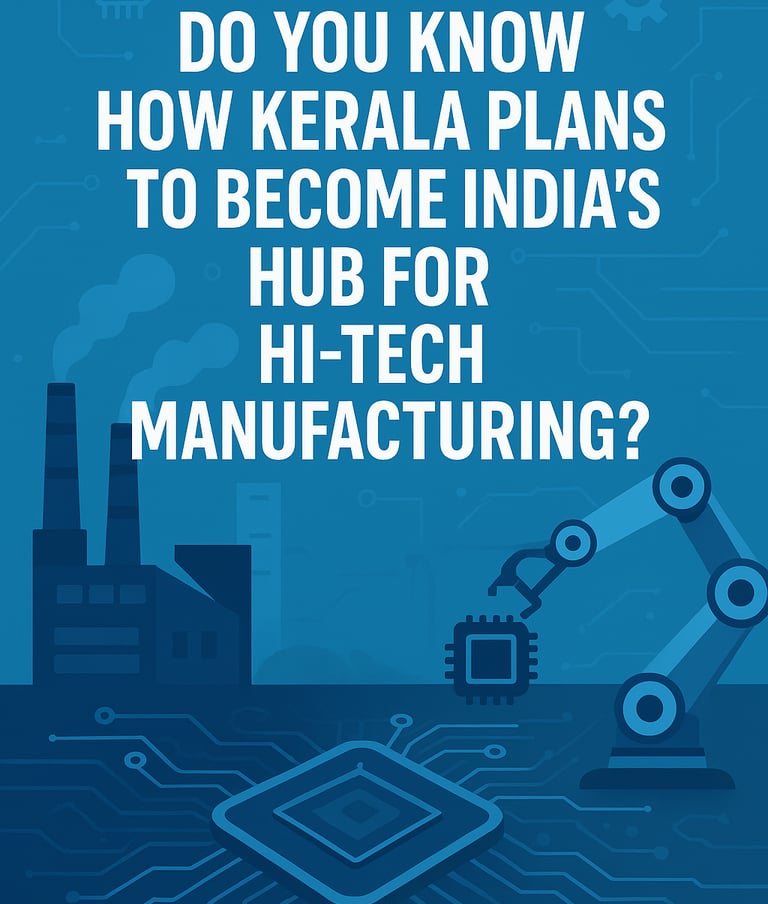Do You Know How Kerala is Emerging as India’s Hi-Tech Manufacturing Hub
Kerala is setting ambitious goals to transform itself into India’s hub for hi-tech manufacturing. Learn how government policies, infrastructure, skilled workforce, and global investments are shaping this vision.
TECH & SCIENCEWORLD & POLITICS
Do You Know Team
9/27/20255 min read


Kerala’s Industrial Legacy and the Need for Transformation
For years, Kerala has struggled with a paradox. On the one hand, it boasts India’s highest Human Development Index (HDI), a robust healthcare system, and near-universal literacy. On the other hand, it has lagged behind states like Tamil Nadu, Karnataka, and Maharashtra in industrialization.
Much of Kerala’s economy has traditionally depended on:
Tourism – The backwaters, Ayurveda, and cultural heritage attract global visitors.
Remittances – A significant share of Kerala’s GDP comes from expatriates working in the Gulf.
Agriculture – Rubber, spices, and coconuts have been the backbone of rural livelihoods.
However, these sectors are no longer sufficient to drive sustainable growth in the 21st century. Climate change threatens agriculture, global oil shifts impact remittances, and the COVID-19 pandemic showed the vulnerability of overdependence on tourism.
Kerala now needs an industrial revolution 2.0, one rooted in innovation, advanced manufacturing, and global competitiveness.
Government Vision: The Kerala Hi-Tech Manufacturing Drive
The state government has laid out an ambitious vision under its Kerala Industrial Policy 2023–28 and complementary initiatives like the Kerala Hi-Tech Manufacturing Mission. The goal is to build a robust ecosystem where industries like electronics, aerospace, renewable energy, medical devices, biotechnology, and semiconductors can flourish.
The plan rests on three pillars:
World-class infrastructure – setting up technology parks, industrial corridors, and plug-and-play factories.
Policy support and incentives – tax benefits, single-window clearances, and financial incentives for investors.
Skill development – preparing Kerala’s educated youth for Industry 4.0 jobs.
Emerging Focus Areas of Hi-Tech Manufacturing in Kerala
Unlike traditional manufacturing, hi-tech manufacturing requires precision, R&D investment, and global integration. Kerala is focusing on the following sectors:
1. Electronics and Semiconductors
With India aiming to become a global semiconductor hub, Kerala has identified Kochi and Thiruvananthapuram as potential centers for electronics and chip design. Start-ups in embedded systems, VLSI design, and IoT devices are being encouraged through incubators.
2. Aerospace and Defense Manufacturing
Kerala’s strategic location and skilled workforce make it ideal for defense and aerospace manufacturing. Initiatives are being explored with HAL (Hindustan Aeronautics Limited) and global players for maintenance, repair, and production facilities.
3. Medical Devices and Biotechnology
The MedTech Park in Thiruvananthapuram aims to make Kerala a global exporter of medical equipment. Coupled with the state’s healthcare excellence, biotechnology research in Kochi and Thrissur adds momentum.
4. Renewable Energy and Green Manufacturing
Kerala plans to become a leader in solar panel production, battery storage systems, and green hydrogen technologies. With its strong stance on sustainability, this sector could align Kerala’s industrial growth with its eco-friendly identity.
5. Artificial Intelligence and Robotics
The government is encouraging start-ups in AI-driven automation, robotics, and Industry 4.0 solutions. These will not only support hi-tech manufacturing but also help Kerala build intellectual property.
Infrastructure Push: Building the Backbone of Hi-Tech
No hi-tech hub can succeed without world-class infrastructure. Kerala is investing in:
Kerala Industrial Corridor under the Chennai-Bengaluru Industrial Corridor (CBIC), connecting ports and airports with manufacturing hubs.
Kochi Smart Industrial City – A futuristic industrial township with integrated living and working spaces.
Technopark, Infopark, and Cyberpark expansions – Evolving from IT services to product-based tech R&D.
Skill Parks and Centers of Excellence – Training students in chip design, robotics, and advanced electronics.
Attracting Global Investors
Kerala understands that to compete with Tamil Nadu or Gujarat, it must attract foreign direct investment (FDI). The state has been actively pitching itself at global forums, highlighting:
High literacy and skilled workforce
Robust social infrastructure (healthcare, education, quality of life)
Proximity to international shipping routes via Kochi Port
Investor-friendly policies with faster clearances
Companies from Japan, Germany, and the US have already shown interest in renewable energy, MedTech, and electronics projects.
Kerala’s Edge Over Other States
While states like Karnataka and Maharashtra are already ahead, Kerala has some unique advantages:
Highly educated population – perfect for knowledge-driven industries.
Strong diaspora networks – expats bringing capital, connections, and know-how.
Quality of life – attracting global professionals who prefer Kerala’s environment over crowded metros.
Sustainability branding – Kerala can market itself as India’s green hi-tech hub.
Challenges on the Road Ahead
Of course, the journey is not without hurdles. Kerala must overcome:
High cost of land and wages compared to other states.
Bureaucratic red tape despite reforms.
Logistics bottlenecks – limited industrial land and port congestion.
Need for massive skill upgradation – not just literacy, but advanced technical expertise.
If Kerala can address these systematically, its dream of becoming a hi-tech hub can become a reality.
What This Means for Kerala’s People
For ordinary Keralites, this transformation means:
New job opportunities in semiconductors, AI, robotics, and green tech.
Reverse brain drain – professionals who migrated abroad may return.
Higher wages and better working conditions compared to traditional industries.
Opportunities for start-ups and small enterprises to plug into global supply chains.
This shift could fundamentally alter Kerala’s economic story — from being a service- and remittance-driven state to a manufacturing powerhouse.
FAQs
Q1: Why is Kerala focusing on hi-tech manufacturing now?
Kerala needs to diversify its economy beyond tourism, agriculture, and remittances. Hi-tech manufacturing offers high-value jobs and global competitiveness.
Q2: Which sectors are being prioritized?
Electronics, semiconductors, aerospace, medical devices, renewable energy, and AI-driven automation.
Q3: How will ordinary citizens benefit?
Through new job opportunities, higher wages, better living standards, and potential reverse brain drain.
Q4: Can Kerala compete with established hubs like Bengaluru or Chennai?
Yes, by carving out a niche in sustainable, green, and high-value manufacturing with strong human capital.
Q5: What challenges remain?
Land costs, logistics, bureaucratic delays, and the need for advanced skill development.
Conclusion
Kerala’s ambition to become India’s hub for hi-tech manufacturing is both bold and timely. The state is leveraging its strengths — education, healthcare, and sustainability — while addressing its weaknesses through infrastructure and policy reforms.
If the vision succeeds, Kerala could inspire other states to pursue technology-driven industrialization while maintaining social equity and environmental balance. More importantly, it could give India a globally competitive edge in high-value manufacturing.
The road will not be easy, but as history shows, Kerala has always been a land of firsts — the first state with 100% literacy, the first to focus on social development, and now potentially the first to marry sustainability with hi-tech manufacturing.
Kerala is ready to prove that the next Silicon Valley or Shenzhen may not be in the West or East — it could very well rise from the lush green landscapes of God’s Own Country.
#KeralaHiTech #MakeInIndia #ElectronicsManufacturing #KeralaDevelopment #India2030 #GreenManufacturing #SemiconductorsIndia #DoYouKnow
Kerala, known for its backwaters, lush greenery, and high literacy rate, is now preparing for a bold transformation — to become India’s leading hub for hi-tech manufacturing. For decades, the state has been associated more with tourism, remittances from the Gulf, and a strong services economy rather than heavy industry. However, in a world rapidly shifting towards digital transformation, smart electronics, and advanced manufacturing, Kerala has realized that its next growth story lies in technology-driven industrialization.
This transition is not just an economic necessity but a social and strategic one. With rising unemployment, especially among educated youth, Kerala needs to create new avenues of high-paying, future-ready jobs. By positioning itself as a hub for hi-tech manufacturing, the state hopes to integrate into global supply chains, reduce dependency on imports, and become a major contributor to India’s vision of a $10 trillion economy by 2035.
So, how exactly does Kerala plan to achieve this ambitious dream? What policies, infrastructure projects, and industrial partnerships are driving this vision? And most importantly, what will this mean for entrepreneurs, workers, and the common citizen of Kerala?
Let’s dive deep into this unfolding story.
Knowledge
Empowering minds with reliable educational content daily.
Newsletter Signup
© 2025 DoYouKnow. All rights reserved.
Stay Ahead of the Trends – Join Our Newsletter
